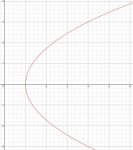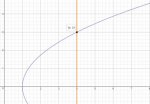MissTrinity
New member
- Joined
- Sep 18, 2018
- Messages
- 5
This is the question I've encountered

I have managed to get this form x= y2/3 +1
I have checked the graph from both forms and the vertex lies on (1,0)
 (as shown in this graph)
(as shown in this graph)
The part which I am confused at is how was the vertex was solved, I am very familiar of this form y=ax2+bx+c and yet as I saw the equation I began to get confused and couldn't use the formulas used to find vertex though I tried severely here is what I got
This is my entire solution, but please do ignore x=4 since this is calculus problem though I am much concern on how to graph this new equation I just encountered, it just felt new to me i haven't encountered or recall encountering this back in analytic geometry
 (i tried, im confused still)
(i tried, im confused still)
Thank you so much and hope to get a reply soon, it will be a big help

I have managed to get this form x= y2/3 +1
I have checked the graph from both forms and the vertex lies on (1,0)
 (as shown in this graph)
(as shown in this graph)The part which I am confused at is how was the vertex was solved, I am very familiar of this form y=ax2+bx+c and yet as I saw the equation I began to get confused and couldn't use the formulas used to find vertex though I tried severely here is what I got
This is my entire solution, but please do ignore x=4 since this is calculus problem though I am much concern on how to graph this new equation I just encountered, it just felt new to me i haven't encountered or recall encountering this back in analytic geometry
 (i tried, im confused still)
(i tried, im confused still)Thank you so much and hope to get a reply soon, it will be a big help





